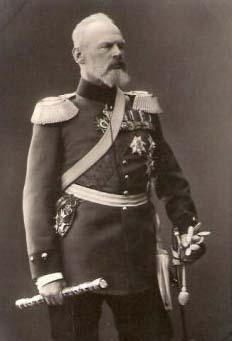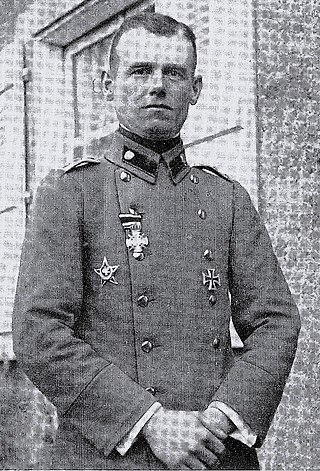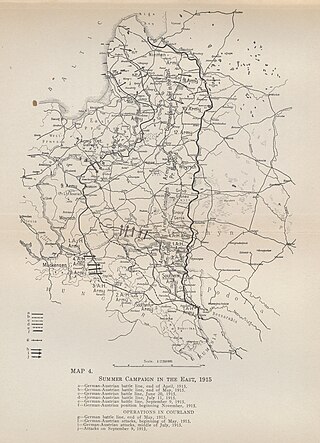Sources
This article includes a list of references, related reading, or external links, but its sources remain unclear because it lacks inline citations .(January 2016) |
The Army Group Prince Leopold of Bavaria (German: Heeresgruppe Prinz Leopold von Bayern) was an Army Group of the German Army, which operated against Russia between 5 August 1915 and 15 December 1917 during World War I. It was renamed Army Group Woyrsch on 29 August 1916.
This Army Group was established in August 1915 after the conquest of Warsaw by the 9th Army under command of Prince Leopold of Bavaria. It was only composed of the 9th Army and an Army Detachment. When the 9th Army was disbanded in July 1916 to be reformed in the Balkans, the Army Group remained in existence, but now under command of von Woyrsch, because Prince Leopold of Bavaria became Supreme commander of the Eastern Front. The Army Group was finally disbanded on 15 December 1917.
This article includes a list of references, related reading, or external links, but its sources remain unclear because it lacks inline citations .(January 2016) |

Prince Leopold of Bavaria was born in Munich, the second son of Prince Regent Luitpold of Bavaria (1821–1912) and his wife Archduchess Augusta of Austria (1825–1864). He was a Field Marshal (Generalfeldmarschall) who commanded German and Austro-Hungarian forces on the Eastern Front in World War I.
An army group is a military organization consisting of several field armies, which is self-sufficient for indefinite periods. It is usually responsible for a particular geographic area. An army group is the largest field organization handled by a single commander – usually a full general or field marshal – and it generally includes between 400,000 and 1,000,000 soldiers.

Alexander Adolf August Karl von Linsingen was a German general during World War I.
The 89th Infantry Division was a formation of the Imperial German Army in World War I. The division was formed in November 1914 as the provisional Westernhagen Division, named after its commander. The nucleus of the unit was troops collected at Posen. It became the 89th Infantry Division in August 1915. The division was disbanded in 1919 during the demobilization of the German Army after World War I.

The Bavarian Cavalry Division was a unit of the Royal Bavarian Army, part of the German Army, in World War I. The division was formed on the mobilization of the German Army in August 1914. The division was disbanded in 1919, during the demobilization of the German Army after World War I. The division was raised and recruited in Bavaria.

The 6th Army was an army level command of the German Army in World War I. It was formed on mobilization in August 1914 from the IV Army Inspectorate. The army was disbanded in 1919 during demobilization after the war.

Armee-Abteilung Woyrsch was an army level command of the German Army in World War I. It served on the Eastern Front throughout its existence.

Willy Martin Ernst Rohr was a German Army officer who was a major contributor to the development of infantry tactics in World War I, particularly for the system of Storm Battalions.

The leaders of the Central Powers of World War I were the political or military figures who commanded or supported the Central Powers.
The Army Group Mackensen which operated in Serbia between 18 September 1915 and 11 October 1916 during World War I under the command of field marshal Mackensen, was an Army Group of the German Army.
It was renamed on 11 October 1916 to Army Group Below and on 23 April 1917 to Army Group Scholtz, according to its new commander.
The Army Group Mackensen which operated in Poland between 22 April 1915 and 8 September 1915 during World War I under the command of Field Marshal August von Mackensen, was an army group of the Imperial German Army.
The Army Group Mackensen which operated against Romania between 28 August 1916 and 7 May 1918 during World War I under the command of field marshal Mackensen, was an Army Group of the Imperial German Army.
The Army Group Boehn was an Army Group of the German Army, which operated on the Western Front under command of Max von Boehn, between 12 August 1918 and 8 October 1918 during World War I.
Army Group Gallwitz, or Army Group C, was an Army Group of the Imperial German Army during World War I. Commanded by Max von Gallwitz, it operated on the Western Front between 1 February and 11 November 1918.

The Army Group Rupprecht of Bavaria or Army Group A was an Army Group of the German Army, which operated on the Western Front under command of Rupprecht, Crown Prince of Bavaria, between 28 August 1916 and 11 November 1918 during World War I. It was formed from the short-lived Army Group Gallwitz under Max von Gallwitz.
The Army Group Duke Albrecht or Army Group D was an Army Group of the German Army, which operated on the Western Front under command of Albrecht, Duke of Württemberg, between 7 March 1917 and 11 November 1918 during World War I.
The Army Group German Crown Prince or Army Group B was an Army Group of the German Army, which operated on the Western Front under command of Wilhelm, German Crown Prince, between 1 August 1915 and 11 November 1918 during World War I.
The Army Group Hindenburg was an Army Group of the German Army, which operated in the Baltics against Russia between 5 August 1915 and 30 July 1916 during World War I, under command of Ober Ost Paul von Hindenburg.

The Bug-Narew Offensive from July 13 to August 27, 1915 was a major German victory during World War I on the Eastern Front. The Imperial German Army broke through 4 heavily fortified positions, inflicted defeats on superior enemy forces and pushed the Russian Army 300 km to the east, capturing 215,000 prisoners. But the German army also suffered relatively heavy casualties, about 30,000 killed and missing.

The Vistula–Bug offensive from July 13 to August 28, 1915, was a major Central Powers offensive with the decisive role of the German Imperial Army during World War I on the Eastern Front to defeat the forces of the Russian army in South Poland and Galicia.